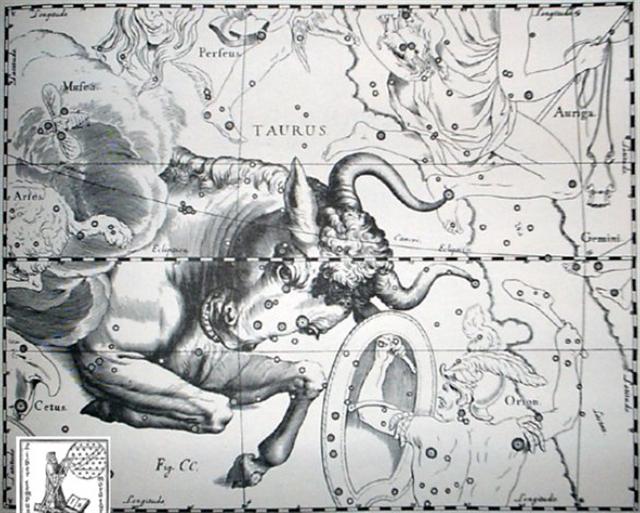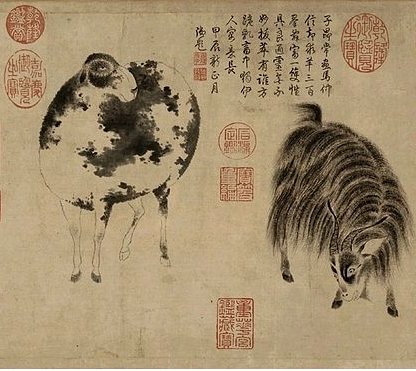91. There was a
place for
'crossing over'
when the Full
Moon was in the
night of
'December 27
(360 + 1), a
place where the
Sun should be in
day 6 * 29˝ + 1:
|
time
of the Bull |
 |
 |
 |
 |
 |
|
Ca5-12 |
Ca5-13 (118) |
Ca5-14 |
Ca5-15 |
Ca5-16 (11 * 11) |
|
te maitaki |
te henua |
kua haga te mea ke |
manu puoko i tona ahi |
kua heu te huki |
|
CLOSE TO THE FULL MOON (and nakshatra dates): |
|
Nga
Kope Ririva Tutuu Vai A Te Taanga
(=
Ξ, Χ, Ζ in ARGO NAVIS?) |
|
AZMIDISKE
(Ξ) |
Φ Gemini
(*118) |
DRUS
(χ) |
Ω Cancri |
NAOS
(Ζ) |
|
July
16
'June
19
"June 5
MAY 13
(5-13) |
17
20
(*91)
6
(157 = 471 / 3)
14 |
18
SOLSTICE
7
(500 =
135 + 365) |
19
(200)
22 (136
+ 37)
8
(*79)
16
(136) |
20
(*121)
23
9
17
(*57) |
|
INVISIBLY CLOSE TO THE SUN (helical dates): |
|
ALTAIR
(*300) |
Φ AQUILAE |
|
Τ AQUILAE |
|
|
January 15
'December 19
NOVEMBER 12 |
16
20
13 |
17
SOLSTICE
14 |
18
22
15 |
19
(384)
23
(357)
16
(320) |
 |
 |
 |
 |
|
Ca5-17 |
Ca5-18 |
Ca5-19 |
Ca5-20 (5 * 5 * 5) |
|
hakahaga-na te honu |
tagata moe hakarava hia |
ka moe |
hakapeka-ga mai |
|
CLOSE TO THE FULL MOON (and nakshatra dates): |
|
HEAP OF FUEL =
Μ |
TEGMINE =
Ζ |
AL TARF
(The End)
= Β Cancri |
BRIGHT
FIRE
= Λ |
|
ST JOHNS
DAY |
'June 25 |
26 (177 = 6 * 29˝) |
27 (361 - 183) |
|
Maro 10 |
"June 11 |
12 |
13 (164) |
|
INVISIBLY CLOSE TO THE SUN (helical dates): |
|
TSEEN FOO (Heavenly Raft) = θ Aquilae
(Ant.) |
TSO KE (Left Flag) = ρ Aquilae
|
GREDI = α
Capricorni
|
DABIH = β Capricorni |
|
CHRISTMAS
EVE |
'December 25 |
26 (360) |
27 |
|
... Midsummer is the flowering season of the
oak, which is the tree of endurance and
triumph, and like the ash is said to 'court
the lightning flash'. Its roots are believed
to extend as deep underground as its
branches rise in the air - Virgil mentions
this - which makes it emblematic of a god
whose law runs both in Heaven and in the
Underworld ... The month,
which takes its name from Juppiter the
oak-god, begins on June 10th and ends of
July 7th. Midway comes St. John's Day, June
24th, the day on which the oak-king was
sacrificially burned alive. The Celtic year
was divided into two halves with the second
half beginning in July, apparently after a
seven-day wake, or funeral feast, in the
oak-king's honour ... |
|
Makoi
named the place Hanga Te Pau, 'the
landing site of Ira'. So that they
would remember (? he aringa,
literally, 'as face'), the open side of
Hanga Te Pau was given this name. Ira
got up. They all climbed to the top of the
hill. They climbed up on the tenth day of
the month of June 'Maro'. |
 |
 |
 |
|
Ca5-21 |
Ca5-22 |
Ca5-23 (2 * 64) |
|
'June 28 |
29 |
SIRIUS |
|
te Rei |
te manu |
te henua |
| |
|
NUNKI = σ Sagittarii |
|
'December 28 |
29 |
30 (280 + 84) |
It should have been deduced that in
Roman times there would have been 4 days from heliacal
Al Tarf and nakshatra Gredi - in day 177 = 6 * 29˝
counted from 'January 1 - to heliacal Sirius and
nakshatra Nunki, and Sirius could then have been imagined as
a central 'royal star fish'
keeping pace with the Sun. 181 (Sirius) + 11 (from
winter solstice to 'January 1) = 192 = 4 * 48.
Ptolemaios had 48 constellations:
"Ptolemy scientifically followed with
those now known as the ancient forty-eight, in the 7th
and 8th books of the Syntaxis, twelve of the
zodiac with twenty-one northern and fifteen southern,
made up by 1028 [= 2 * 514] stars, including 102
αμόρφωτοι, all
probably from Hipparchos, although with some
acknowledged alterations by himself ..." (Allen)
Julius Caesar had determined the beginning of
the Sun calendar year to a position which was 68 + 16
(minimum distance before returning to visibility) =
84 days earlier than where Aldebaran (*68) once upon a
time had been
(viz. in MARCH 25, 3-25). 'March 25 was day 84 counted from
'January 1 and in Roman times *68 - 27 (precessional
depth from the time of rongorongo to the time of Caesar)
= *41 ('May 1) had been the place for the true heliacal
rising of Aldebaran.
When Sirius had risen with the Sun in
'June 30 (181) the corresponding star at the Full Moon
had been Nunki in 'December 30 (181 + 183 = 364).
... This [σ]
has been identified with Nunki of the Euphratean
Tablet of the Thirty Stars, the Star of the
Proclamation of the Sea, this Sea being the
quarter occupied by Aquarius, Capricornus, Delphinus,
Pisces, and Pisces Australis. It is the same space in
the sky that Aratos designated as Water
...

And when once upon a time Aldebaran had risen with the
Sun at the place corresponding to the Julian spring equinox it
would have meant the Sun was on
his way up from the Southern Hemisphere and that he was
here (at Aldebaran) crossing over.

At the time of the Bull Aldebaran should
have
marked the Navel of the Sun in the same sense as 68
precessional days later (at the time of rongorongo) the
topknot of Taranga now was at the Navel of the
Sun (Horse) -
Al Surrat al Faras (=
Sirrah). Or at the navel of the Sky-Father (Wakea),
or at the Road of the Spider (ke
ku'uku'u).
The unlucky Explorer
Kuukuu
corresponded to Mars and to the northern spring equinox month
of March (in Swedish: Mars) and at that time
the equator of the sky was crossed over by the ecliptic
path of the Sun and the other moving stars (planets).
... Then
three lines are drawn east and west, one across the
northern section indicates the northern limit of the Sun
(corresponding with the Tropic of Cancer) about the 15th
and 16th days of the month Kaulua (i.e., the 21st
or 22nd of June) and is called ke alanui polohiwa a
Kane, the black-shining road of Kane. The
line across the southern section indicates the southern
limit of the Sun about the 15th or 16th days of the
month Hilinama (December 22) and is called ke
alanui polohiwa a Kanaloa, the black-shining road of
Kanaloa. The line exactly around the middle of
the sphere is called ke alanui a ke ku'uku'u, the
road of the spider, and also ke alanui i ka Piko a
Wakea, the way to the navel of Wakea (the
Sky-father). Between these lines are the fixed stars of
the various lands, na hokupaa a ka aina. (These
are the stars which hang suspended in the zeniths of the
Polynesian islands most of which lie within the
tropics.) On the sides are the stars by which one
navigates ...
I have named the type of glyph
in Ca5-20 accordingly:
|
 |
 |
|
pito |
quincunx |
|
Pito
1. Umbilical cord; navel; centre
of something: te pito o te henua, centre
of the world. Ana poreko te poki, ina ekó
rivariva mo uru ki roto ki te hare o here'u i te
poki; e-nanagi te pito o te poki, ai ka-rivariva
mo uru ki roto ki te hare, when a child is
born one must not enter the house immediately,
for fear of injuring the child (that is, by
breaking the taboo on a house where birth takes
place); only after the umbilical cord has been
severed can one enter the house. 2. Also
something used for doing one's buttons up
(buttonhole?). Vanaga.
Navel. Churchill. H Piko
1. Navel, navel string, umbilical cord. Fig.
blood relative, genitals. Cfr piko pau 'iole,
wai'olu. Mō ka piko, moku ka piko,
wehe i ka piko, the navel cord is cut
[friendship between related persons is broken; a
relative is cast out of a family]. Pehea kō
piko? How is your navel [a facetious
greeting avoided by some because of the double
meaning]? 2. Summit or top of a hill or
mountain; crest; crown of the head; crown of the
hat made on a frame (pāpale pahu); tip of
the ear; end of a rope; border of a land;
center, as of a fishpond wall or kōnane
board; place where a stem is attached to the
leaf, as of taro. 3. Short for alopiko.
I ka piko nō 'oe, lihaliha (song), at the
belly portion itself, so very choice and fat. 4.
A common taro with many varieties, all with the
leaf blade indented at the base up to the
piko, junction of blade and stem. 5. Design
in plaiting the hat called pāpale 'ie. 6.
Bottom round of a carrying net, kōkō. 7.
Small wauke rootlets from an old plant.
8. Thatch above a door. 'Oki i ka piko,
to cut this thatch; fig. to dedicate a house.
Wehewehe. |











